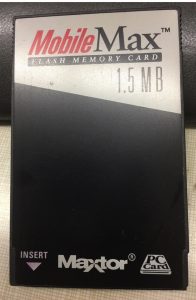History (1994): Maxtor MobileMax
PCMCIA HDD with first fluid dynamic bearing spindle motor
This is a Press Release edited by StorageNewsletter.com on July 12, 2018 at 2:20 pmThis article comes from WikiFoundry, Inc.
1994 – Maxtor MobileMax 105 and 131
First Fluid Dynamic Bearing (FDB) spindle motor

Why it’s important
By eliminating ball bearings, the FDB spindle motor provided lower cost, higher reliability and improved track following accuracy thereby enabling continued increases in capacity at lower cost. By 2004 over 90% of the HDD’s had adopted FDB’s.
Discussion
FDB motors utilize a viscous oil rather than metal ball bearings. This advanced technology enables increased performance, capacity and reliability, while significantly reducing drive acoustics and susceptibility to shock.
The principle advantage of these motors is the substantial reduction in non-repeatable run-out allowing tracks to be placed closer together. In addition, while typical ball bearing motors can withstand up to 150G of shock, fluid dynamic bearing motors have been tested up to 1,200G. FDB motors are acoustically superior to traditional ball bearing motors because they have no metal-to-metal contact and therefore produce very little noise. With no metal-to-metal contact, fluid bearing motors theoretically have an infinite fatigue-life.
The Maxtor MobileMax family (105 and 131MB capacity) which shipped in April 1994 is the first known production use of FDB spindle motors in HDDs. Maxtor adopted these motors in order to achieve the low 10.5mm height necessary to fit into a PCMCIA Type III form factor and stopped using them after investment in this form factor was curtailed by Maxtor in early 1995. The initial motor was jointly developed with Phillips but the design proved to be unreliable and development was then moved to Panasonic.
Gus Klerks and Forrest Titcomb were key engineers on this motor development.
A prototype 105MB MobileMax prototype was displayed at in the IBM booth at Comdex in the fall of 1992.
Disk drive manufacturers such as CDC and Hewlett Packard are know to have experimented with FDB spindle motors but none are believed to have shipped such motors prior to Maxtor.
Seagate began development in 1994 and first introduced its FDB spindle motors in the Medalist Pro family which was announced during the fourth quarter of 1997 and volume production began during the first quarter of 1998.
The family consisted of
• Medalist Pro, ST39140A at 9.1GB,
• Medalist Pro, ST36530A at 6.5GB,
• Medalist Pro, ST34520A at 4.5GB
Seagate’s development was led by Gunther Heine, a prolific inventor with about 40 patents in the area of FDB spindle motors.
Seagate licensed and cross-licensed its patents with both key motor vendors Minibea and Nidec.
By 2004, the industry had switched to FDB motors mainly manufactured by Nidec.
Maxtor US Patents on hydrodynamic spindle bearings:
5,822,152, Ultra-slim disk storage unit with an enclosed circuit board and a hydrodynamic bearing assembly which forms a stable meniscus
5,726,829, Axial spindle motor for hard disk drive assembly
5,488,523, Ultra-slim disk storage unit having a hydrodynamic bearing assembly which forms a stable meniscus
5,328,271, Hydrodynamic spindle bearing for ultra-slim disk storage unit
5,284,391, Apparatus for adjustment of a hydrodynamic spindle bearing assembly














 Subscribe to our free daily newsletter
Subscribe to our free daily newsletter

